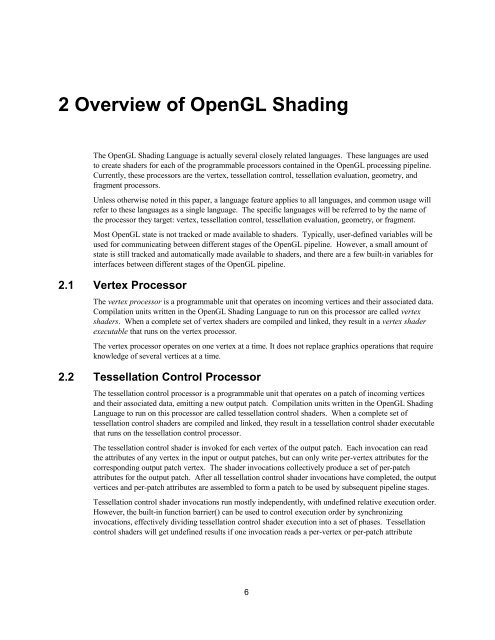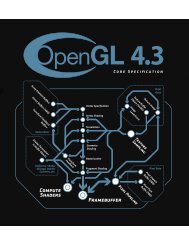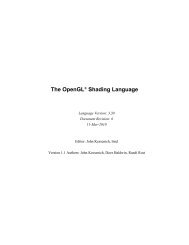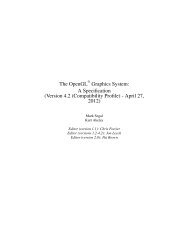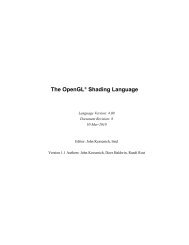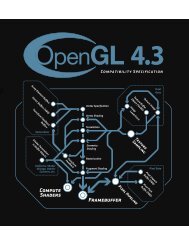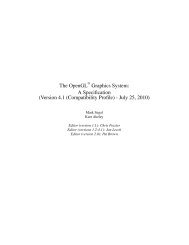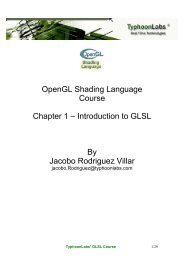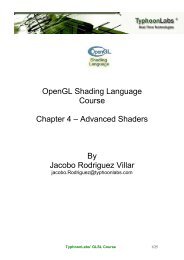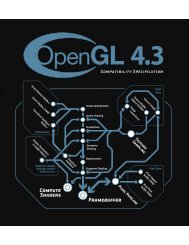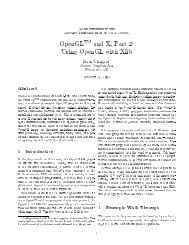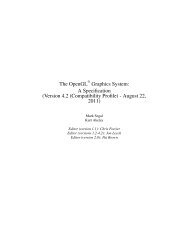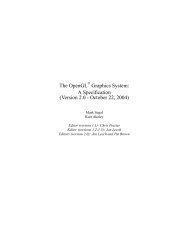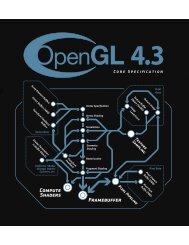Create successful ePaper yourself
Turn your PDF publications into a flip-book with our unique Google optimized e-Paper software.
2 Overview of OpenGL Shading<br />
The OpenGL Shading Language is actually several closely related languages. These languages are used<br />
to create shaders for each of the programmable processors contained in the OpenGL processing pipeline.<br />
Currently, these processors are the vertex, tessellation control, tessellation evaluation, geometry, and<br />
fragment processors.<br />
Unless otherwise noted in this paper, a language feature applies to all languages, and common usage will<br />
refer to these languages as a single language. The specific languages will be referred to by the name of<br />
the processor they target: vertex, tessellation control, tessellation evaluation, geometry, or fragment.<br />
Most OpenGL state is not tracked or made available to shaders. Typically, user-defined variables will be<br />
used for communicating between different stages of the OpenGL pipeline. However, a small amount of<br />
state is still tracked and automatically made available to shaders, and there are a few built-in variables for<br />
interfaces between different stages of the OpenGL pipeline.<br />
2.1 Vertex Processor<br />
The vertex processor is a programmable unit that operates on incoming vertices and their associated data.<br />
Compilation units written in the OpenGL Shading Language to run on this processor are called vertex<br />
shaders. When a complete set of vertex shaders are compiled and linked, they result in a vertex shader<br />
executable that runs on the vertex processor.<br />
The vertex processor operates on one vertex at a time. It does not replace graphics operations that require<br />
knowledge of several vertices at a time.<br />
2.2 Tessellation Control Processor<br />
The tessellation control processor is a programmable unit that operates on a patch of incoming vertices<br />
and their associated data, emitting a new output patch. Compilation units written in the OpenGL Shading<br />
Language to run on this processor are called tessellation control shaders. When a complete set of<br />
tessellation control shaders are compiled and linked, they result in a tessellation control shader executable<br />
that runs on the tessellation control processor.<br />
The tessellation control shader is invoked for each vertex of the output patch. Each invocation can read<br />
the attributes of any vertex in the input or output patches, but can only write per-vertex attributes for the<br />
corresponding output patch vertex. The shader invocations collectively produce a set of per-patch<br />
attributes for the output patch. After all tessellation control shader invocations have completed, the output<br />
vertices and per-patch attributes are assembled to form a patch to be used by subsequent pipeline stages.<br />
Tessellation control shader invocations run mostly independently, with undefined relative execution order.<br />
However, the built-in function barrier() can be used to control execution order by synchronizing<br />
invocations, effectively dividing tessellation control shader execution into a set of phases. Tessellation<br />
control shaders will get undefined results if one invocation reads a per-vertex or per-patch attribute<br />
6


